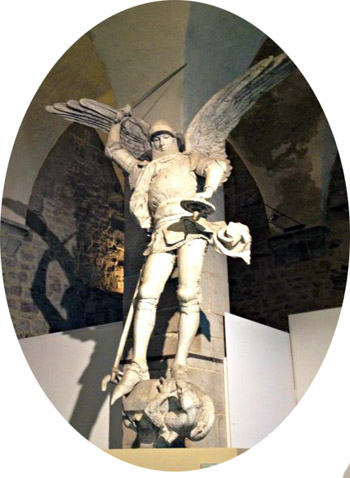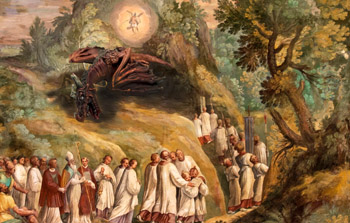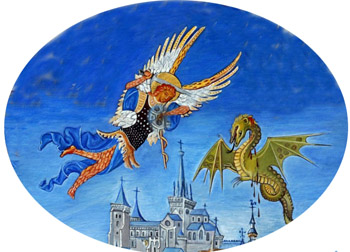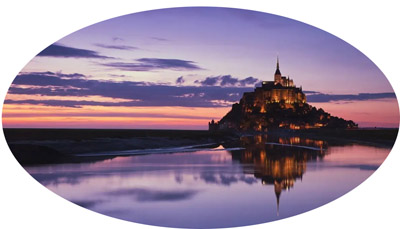Stories & Legends
 |
 |
 |
 |
 |
 |
 |
St. Michael Slays a Dragon
with a Small Shield & Sword
It is from Abbot Baudri’s chronicle that this legend is taken.
.
At Mont Saint-Michel, formerly called Mont Tombe, one can see a circular brass shield decorated with the sign of the Holy Cross in four places, as well as a dagger configured like a sword with a warlike appearance, although small in size. But these weapons are, according to tradition, a manifestation of blessed St. Michael, who used them to conquer a terrible dragon.

St. Michael with his short sword & small shield
used to slay the massive
dragon
After that fierce battle, St. Michael ordered Blessed Aubert, the venerable Bishop of Avranches, to send those relics to the Sanctuary of Mont Tombe – which became Mont Sant Michel. Then he ordered him to build a church there to consecrate and dedicate it to divine service with the help of God.
Now then, at that time, beyond England in a very distant country governed by a King named Elga, a monstrous dragon appeared with a very harmful pestilential breath, its entire body bristling with scales, its head topped with terrifying crests. From its venomous mouth came fire that burned trees and plants.
This immense dragon killed men and animals and poisoned the air with his foul breath. He occupied the land, habitually staying near a limpid and fresh spring that fed into a river that supplied the area with water. But now no one dared to come there to get it, because this unspeakable monster reigned there as absolute master and kept everyone at bay.
This was a terrible ordeal for the people of the surrounding area, who were tormented by the lack of water and unable to irrigate their lands. A terrible anguish therefore afflicted the people. Deprived of all human help, they turned to the wisdom of God. They called upon Bishop Aubert of Avranches, famed for his holiness, and, through him, presented their grievances to the Creator of all things.
.
Bishop Aubert came to that region whose vegetation had been reduced to embers and bleached. This Bishop commanded the people to make a three days' fast and ordered that abundant alms to be given.
Then, all the inhabitants armed themselves and marched to the site where the dragon stayed. They were accompanied by the clergy, who walked in procession imploring the succor of Heaven to give strength to the people to destroy the dragon.

The procession went up the mountain and found the dragon slain by an unknown hand
But great was their astonishment when, having nearly reached the place of his retreat, they found the dragon dead. They rushed upon it and cut to pieces.
Then, in wonder and amazement, they saw a small shield and sword nearby. And since they seemed weapons not fit for such a great battle, the Bishop supplicated God to reveal the secret of that great mystery.
The Bishop spent the night in constant prayer. And indeed, before his eyes appeared a great heavenly Warrior who spoke to him thus:
“I am Michael who attends always before the presence of God. I am he who incessantly battles the enemy and who – have no doubt about this – came as your champion. I killed that beast, which you could not do because of your impotence.”
“Do not doubt,” he continued, “that these were my weapons, nor that I needed any greater armor or sword.”
Then, he instructed the Bishop to take the relics and bring them to “the mountain beyond the sea dedicated to my name.”
.
Bishop Aubert made known the Archangel's response to the people. Then, he hastened to do the Archangel’s bidding and to have these gifts carried beyond the sea. Choosing four people from among the notables of the country, he asked them to cross the sea and instructed them on what they should do.

St. Michael slays the dragon
They, therefore, crossed the sea with the resolve to go to the ancient Shrine of St. Michael the Archangel on Mount Gargano in Italy. They disembarked and set out, but to no avail. Along the way, they got lost and wandered to and fro.
So they said to one another: “What is this? What has happened to us? What are we doing? We have been traveling for several days already and we have not made any progress. Near here, in Normandy, as we have been told, there is a mountain called Mont Tombe. Perhaps that is our destination. Let us entrust ourselves once again to the patronage of him whose triumph is a source of glory for our homeland.”
Then, they made way without problem to the sanctuary, where they offered the shield and the sword, telling the whole story point by point and vouching for it. These objects were received with the respect due to them and exhibited with honor for the benefit of future generations so that they bear witness to the great feat of St. Michael and recall its memory.
Abbot Baudri of Bourgueil ends his account with these words: “This is what I, Baudri, a Bishop unworthy of being so, learned from the mouth of the venerable Prior [of Mont Sant-Michel] and I could not refuse to believe it, because comparable things I have heard from others and there are yet other such marvelous things that I myself have seen and heard.
.
"What I learned about these objects from a trustworthy narrator, I – a trustworthy narrator – have recorded as best I could in this writing, lest one day this beautiful story might lose its meaning and credibility, and might perhaps disappear, exposed to jealous time which devours everything. …

St. Michael order the relics
to be taken to Mont Saint Michel
“To those who read these lines without making mockery, let them have deep peace, happiness and joy! Amen.”
And in fact, this very sword and shield of St. Michael were seen by Archbishop of Baureux Henri-Marie Boudon in the year 1667. On the day of the feast of Apparition of the glorious St. Michael, he tells us in his well known book on Devotion to the Holy Angels (1668):
“I had the honor and the blessing of beholding at this sacred spot these precious tokens of the incomparable love of this great Prince of Paradise for men, that is, the shield and the sword of St. Micahel, which are preserved there in the treasury of the Church."
Sadly these relics were destroyed or lost in those bitter years of the French Revolution. We pray they will be brought to light in the Reign of Mary so that again due honor may be paid them.
.

Mont Saint Michel, a medieval wonder

Adapted from Chroniques latines du Mont Saint-Michel
(9th-12th siècle)
by Bishop Baldri, Abbot of Bourgueil & Bishop of Dol-en-Bretagne (1046-1130), “Baudri, I-XII.”
Posted October 7, 2023
by Bishop Baldri, Abbot of Bourgueil & Bishop of Dol-en-Bretagne (1046-1130), “Baudri, I-XII.”
Posted October 7, 2023






